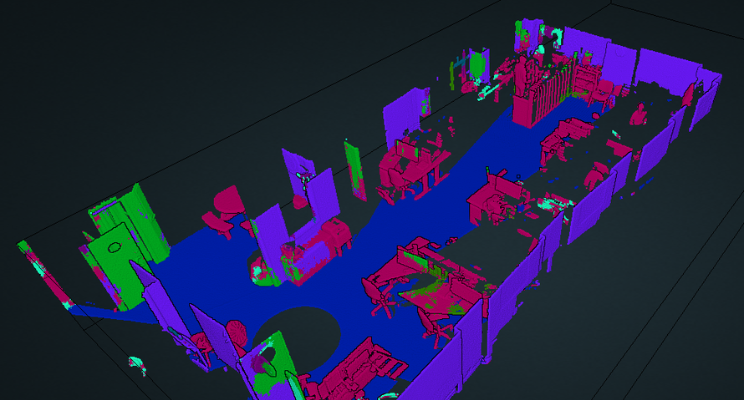How to unlock the value of point cloud data with AI and automation

Point clouds offer competitive advantages across industries but, up until now, manual classification has hindered widespread adoption. In this blog, you’ll discover how AI and automation are revolutionizing point cloud processing.
Points clouds are brimming with vast amounts of spatial information, but harnessing the value of this data is often a cumbersome and challenging process. To be valuable, spatial data must be accurately processed and labelled. Otherwise, it cannot be relied upon for effective use.
To tackle this challenge, digital leaders in the point cloud space are innovating with AI and automation to discover and extract objects and features from point cloud data sets. This is what’s known as automated classification and segmentation.
What is Point Cloud Classification & Segmentation?
While classification and segmentation are sometimes considered synonyms, it can be helpful to distinguish them as below:
- Segmentation: A common term in computer science, segmentation is the action of separating point cloud data sets into unique objects
- Classification: Often more associated with remote sensing, classification is the action of interpreting what each object within the point cloud represents.
By automating classification and segmentation, companies can enhance point cloud processing by gathering the information they need at speed and scale — with much less manual intervention. Some examples of this in practice include:
- Tracking construction projects: Change detection enables you to compare building components to track a project’s process and discover potential safety issues.
- 2D/3D modelling: Object identification facilitates accurate geometry processing.
- Noise filtering: Multi-stage analysis discovers and removes outliers or ‘noise’ within scan data to present an accurate, clean image.
- Autonomous vehicles and situational awareness: Real-time data extracted from an autonomous vehicle’s environment can empower the system to make intelligent, contextual-driven decisions that ensure safety.
The origins of Object Detection
The concepts of object detection and automated classification have their origins in the reconstruction of geometry for urban planning and development. While the rollout of this technology seems relatively new, even two decades ago, academics and commercial organisations were looking for ways to improve city modelling through the use of aerial photogrammetry that could then be turned into detailed 3D models.
Over the last few years, as digitisation has accelerated, the reconstruction of geometry from points clouds has entered a new era, enabling city planners and urban development companies to construct richer 3D parametric models. However, the process for many organisations in this domain remains overtly manual, relying on human interpretation and skill to ensure accuracy.
How Artificial Intelligence is changing the game
We are now at a point where classification algorithms have improved to the extent that they can be semi-automated. This means that the user oversees the machine learning algorithms to ensure their accuracy.
As briefly explored above, this machine learning technique offers a lot of promise for organisations across industries — urban planning, automotive, civil engineering, mining and more.
Rather than relying on steadfast geometric rules for detecting objects, machine learning can use pattern recognition to identify object types based on predefined data points. As a result, classification becomes a ‘hands-off’ process. The machine learning algorithm automatically detects and categorises objects without the need for much manual intervention. This makes the entire point cloud process much more scalable, agile and quick.
Vercator: Pioneering an evolution in Point Cloud Classification
At Vercator, we’re no strangers to revolutionising point cloud processing. Already, we’ve helped thousands of companies to enhance their use of cloud-based automation. Now, we’re turning our attention to automated classification.
Through the use of automated machine learning, we’re empowering companies to efficiently, accurately and swiftly segment cloud point data sets into smaller data subsets, based on pre-generated models. The result? Labour-intensive data classification becomes a seamless, effortless process.
At present, Vercator models are available for:
- Interior building structures objects like floors, doors and walls
- Interior residential objects such as furnishings
- Highways and road surfaces
- Rail objects including rails, buildings and track clips
This is just the beginning of the models we plan to release — and we are working on more at present. If you would like support with extracting objects that are not part of our current models, please get in touch. We offer a bespoke development service and will work with you to deliver your optimum segmentation and classification results.
The next frontier
Automation is beginning to revolutionise point cloud data processing, ushering in a new era of classification, object identification and feature extraction. Not only will it make point cloud processing faster, but it will enable more organisations to access the benefits of segmentation and make accurate, insight-led decisions.
As automation takes hold within this space, cloud infrastructure is also rapidly evolving to better facilitate point clouds within the cloud, offering limitless scalability, flexibility and ease of use.
While the changes to come are no doubt great, the journey of change will be well worth it. To keep ahead of the competition, your business needs to be agile and invest in the software that will soon become the backbone of point cloud processing.
That’s where Vercator comes in. Our cloud-based software is at the cutting-edge of innovation in the point cloud processing space. With automatic updates enabled, you’ll always be at the forefront of innovation and you can start with automated classification today.
Point clouds are changing the world and we’re paving the way for organisations of all shapes and sizes, across sectors, to realise the benefits of point cloud automation with our cloud-ready processing algorithms - at an affordable price point.
If you want to see what Vercator can do for you, sign up for a free trial today.
Tags: segmentation


